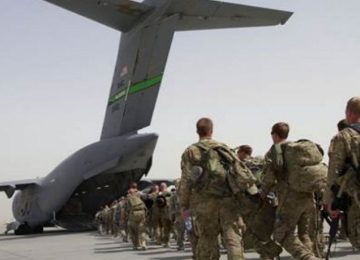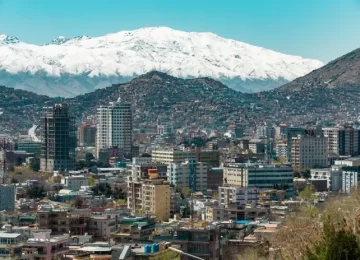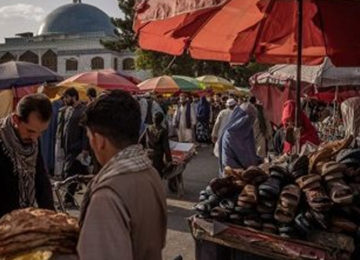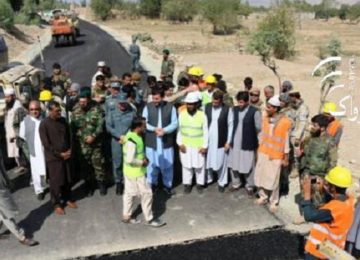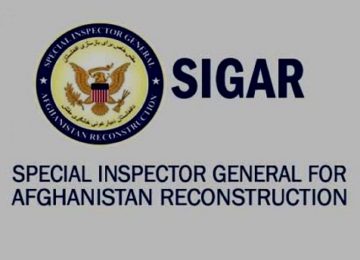The Taleban have failed either to re-enlist or to eliminate a dissident commander in Jawzjan who, as a result of internal Taleban conflicts over territorial control and taxation, has aligned himself with Daesh. A recent military offensive – in which fighters from several provinces were mobilised – remained unsuccessful in the second half of October. As a result, another area in Afghanistan could well emerge as a potential IS foothold – although it is still unclear what the exact nature of the links are between the local command and ‘IS Central’ in Syria/Iraq or its Afghan counterpart in Nangarhar, called ISKP.
During the second half of October 2017, the Taleban deployed hundreds of fighters in Jawzjan province to retake areas under the control of Qari Hekmat, a disgruntled Taleban commander. In 2015 as a result of intra-Taleban conflicts about territorial control and taxation (read AAN’s previous analysis here), Hekmat – the Taleban’s former shadow district governor in his home district Darzab – declared himself and his fighters part of the Islamic State Khorasan Province (ISKP), the Afghan-Pakistani division of the so-called Islamic State (called Daesh by Afghans) centred in Iraq and Syria (for background about its emergence see AAN’s dossier here). Since then, Hekmat has had almost full control over his home district of Darzab in the remote south of Jawzjan, near the border with Faryab and Sar-e Pul. There is no Taleban presence in this district anymore, and Afghan government forces are limited to the district government office as well as to a few bases nearby.
In early October, Hekmat’s fighters went on the offensive and overran most Taleban positions in neighbouring Qush Tepa district. This included the Taleban’s district headquarters located there; this district and Darzab are also under one local Taleban military committee.
According to a Taleban field commander, fighters loyal to Hekmat besieged the Taleban in the villages of Beg Sar, Khanaqa, Gardan and Shir Beg in Qush Tepa at the beginning of October. The local Taleban, he said, retreated to the Astana area of neighbouring Dawlatabad district in Faryab. On 21 October, the Taleban conducted an unsuccessful counteroffensive against Hekmat’s network that continued for five consecutive days. According to locals, while the Taleban were able to re-take a number of villages for a short while, Hekmat’s fighters returned during some of the more recent clashes. Eventually, the Taleban once again retreated to Dawlatabad.
The offensive followed various failed attempts by the Taleban to negotiate Qari Hekmat’s return to the movement. This was driven by their interest in preventing large-scale fighting that might attract attention at both the local and national level. They were particularly keen to avoid infighting among the Uzbek community, which the Taleban only successfully courted relatively recently, ten years ago. This allowed them to successfully establish strong footholds in the Afghan north (for more background detail read this AAN’s report, page 53).
How seriously the Taleban take the challenge posed by Qari Hekmat is reflected by the fact that they mobilised fighters from several provinces against him, from neighbouring Faryab and Sar-e Pul, as well as from faraway Ghor, Badghis and Helmand. The deployment of those fighters, however, is also an indication of their weak leadership at the local level. It was apparently due to their failure in handling Hekmat that the movement replaced the shadow provincial governor along with a number of commanders at the beginning of October. Since promoting the former shadow governor and head of the military committee in the northwest, Mawlawi Abdulrahman, to member of the Taleban’s leadership council, the movement has faced serious challenges in Jawzjan. Abdulrahman, a loyal Taleban figure in the northwest who served as head of the chamber of commerce in Herat province during the Taleban’s Emirate in the 1990s held much sway among local fighters, not only in Jawzjan but also in the northwest. According to a field commander, his successor Mawlawi Sunnatullah, who had previously served as a mid-level commander in Darzab district in Jawzjan, is incapable of leading the Taleban in the province as was reflected by the deployment of external fighters to take on Qari Hekmat.
A three-way conflict
Neither the government nor the Taleban had much influence in the remote districts of Qush Tepa or Darzab. Both districts, in fact, had been controlled by Qari Hekmat on behalf of the Taleban until 2014. The Taleban mainly used this area as a safe haven for fighters from neighbouring Faryab and Sar-e Pul, as government forces – their only adversary before Qari Hekmat’s dissidence – were too weak and incapable of engaging the militants in battle due to a shortage of personnel. They merely kept watch on Hekmat’s activities in these remote districts. The same was true for the Taleban as long as Qari Hekmat did not openly break with them. After his removal from the Taleban’s ranks, the area slipped out of the movement’s control entirely.
With Qari Hekmat’s emergence as an actor independent of and in conflict with the Taleban, and now officially aligned with ISKP, the fighting in this part of Jawzjan has turned into a three-way conflict. At the moment, the government seems to be the weakest party in this triangle. Most of the fighting, as government officials have confirmed, happens between the Taleban and Qari Hekmat’s fighters.
Aminullah, the government’s district governor in Darzab, told AAN, that “due to fears of the fall of the district centre into the hands of either Daesh or the Taleban, government offices have been moved to the provincial centre.” Schools have also remained shut over the past two years. For commander Ismail, Darzab district’s police chief, the security forces are not in a position to conduct a counterattack against militants in the district. He told AAN “We can’t put the lives of our soldiers at risk because there are not enough forces and no timely logistical supply from the central government, if we conduct a counteroffensive against the militants.” Qush Tepa faces similar challenges, limited security personnel and a lack of basic facilities, as well as regular clashes between the Taleban and Hekmat’s fighters. Dozens of families have been forced to flee the area due to recent fighting.
For Qari Hekmat, the location of the two districts he controls is a double-edged sword. It provides a stronghold for him that is out of reach both of the government and, to an extent, the Taleban. But the area is also land-locked, and Qari Hekmat faces two enemies who could mobilise far more resources than what is available to him. The government is stronger in the north of the province around the capital Shebarghan; the Taleban also control some areas in the northern districts (Khamab and Mingajik), as well as in the east of the province (Aqcha, Mardyan and Khaniqa districts; see earlier AAN reporting here). They also keep a presence nearby and still have more military resources.
Meanwhile, the only ISKP stronghold is far away in eastern Afghanistan and under heavy pressure both from the ANSF and US forces. The ISKP cannot, therefore, interfere in Qari Hekmat’s affairs, and neither can it send much help (if it is capable of doing so at all, which is in doubt); and might be happy to portrait his successful activities in the north as their own. In 2016, an attempt to establish contact failed when the Taleban caught and killed an ISKP delegation in Darzab district on its way to meet Hekmat. It is not clear whether that was a unique attempt; in any case, AAN has not heard about any follow-up.
Whether Qari Hekmat plans to expand his influence or his anti-Taleban October offensive was purely a form of ‘forward defence’ to stabilise his grip is unclear. As attempts by a like-minded, disgruntled Taleban commander in nearby Sar-e Pul province to contact him demonstrate (AAN reporting here), there are potential allies in this region of Afghanistan.
Qari Hekmat’s control over Qush Tepa and Darzab may also help him to rise funds from the poppy production in both districts. While Jawzjan province was officially ‘poppy free’ (meaning less than 100 hectares were cultivated with poppy) between 2008 and 2015, figures were significantly higher in 2016. According to UNODC data, there were 85 hectares under poppy cultivation in Darzab in 2016 and 316 hectares in Qush Tepe, for a combined total of 401 hectares – this is 98 per cent of the 409 hectares under poppy cultivation in Jawzjan. The total poppy production for Jawzjan was estimated at 14 metric tons; with the average regional farm-gate price for dry opium at 126 US dollars per kilogram, the value of two district’s total production will have amounted to 1,730,000 US dollars.
Poppy cultivation in Qush Tepe seems to have thrived under Taleban control, but also in Darzab under Qari Hekmat, after he declared himself part of ISKP. (1) This is remarkable insofar as ISKP usually cracks down on the drugs business. The new 2017 UNODC estimates expected for early this week will show whether Qari Hekmat will follow this line or deviate from it – which, in turn, would be an indicator for his commitment to ISKP policies.
How much of an ISKP connection is there?
The exact nature of Qari Hekmat’s affiliation both with IS Central and its self-declared (and accepted) Afghan-Pakistani affiliate, ISKP, is hard to confirm. Qari Hekmat has declared himself a part of ISKP by having his fighters use the ISKP banner when collecting taxes and by issuing decrees with the ISKP logo and letterheads, as two recent ones, from June and August 2017 (see example below), show.
Whether he has sworn allegiance to IS Central is unclear. According to Sharia, if the caliph is not accessible (in this case far away and in hiding somewhere in the Middle East), the declaration can take place in front of a representative of the caliphate. In the case of Qari Hekmat, this would have to be a leader of ISKP, as an accepted branch of the IS. But AAN has not seen any video or statement showing Qari Hekmat’s oath of allegiance or an official confirmation by ISKP or IS Central. In this light, his use of ISKP insignia might just be a tool to threaten the Taleban and the population under his rule, without reflecting much about his real allegiance (see also “Daesh branding as an opportunity” in this AAN analysis).
Consequences for the Taleban
Qari Hekmat’s successfully clinging to Darzab and Qush Tepe, however, is already highly consequential to the Taleban. Their failure to defeat him – at least for the time being, and with such an enormous mobilisation effort – presents the movement with at least two serious problems.
First, Hekmat’s success to hold and consolidate his position against a large Taleban force threatens to reverse important gains in an important part of the country that were the result of a more inclusive policy vis-à-vis the local ethnic majorities. In Jawzjan’s case, these are the Uzbeks who, countrywide, are a minority in Pashtun-dominated Afghanistan and in the Pashtun-dominated Taleban movement. Among them only a limited number of field commanders supported the Taleban during the movement’s first incarnation, from 1994 to 2001. More recently, however, the Taleban in Jawzjan have appointed local non-Pashtuns to most of the movement’s provincial leadership posts, which seems to have strengthened their grip. In Qari Hekmat’s case, however, they now face a reversal in territorial gains (control over two districts) and political gains (as someone else, namely ISKP, might harvest the results of their work).
The fact that Qari Hekmat has held out successfully against the latest Taleban offensive will have also boosted his reputation in the area.
Secondly, and more importantly, this is the first time that a rival group in the north has successfully challenged the Taleban while invoking the name of their latest nemesis, Daesh. Elsewhere, the Taleban have quickly suppressed the attempts of ISKP sympathisers to establish a foothold. In various locations in northern and northeastern Afghanistan, such as Eshkamesh district of Takhar and Burka district of Baghlan province, commanders suspected of sympathising with ISKP have either been dismissed or detained early on (read our previous analysis here and here). The same happened elsewhere in the country in 2014/15, after dissident Taleban groups saw the emergence of the Islamic State in Iraq and Syria as an opportunity to seek new affiliation and funds. The Taleban moved quickly to crush them in Helmand, Farah, Zabul and Logar (AAN background here) and were only unsuccessful in Nangarhar (AAN background here) where fighting between both sides continues (see a media report here). But this was in their Pashtun heartland, and reinforcements were easier to mobilise.
For Daesh Central and ISKP, who are suspected of claiming attacks they sometimes have not conducted, both in Afghanistan and internationally, it would be a prestigious step forwards if Qari Hekmat could hold out against the Taleban in their name over a longer period. Whether they have anything practical to do with Qari Hekmat’s campaign or not, they would be able to claim to own another area in Afghanistan. Finally, it looks unlikely that the Taleban will give up and simply accept Qari Hekmat’s ‘island’ of the two Jawzjan districts as being outside their control.
The recent Taleban offensive against self-declared Daesh commander Qari Hekmat in Jawzjan also undermines claims made on 8 October by General Razeq, the police chief of Kandahar province, that Taleban leader Hebatullah Akhundzada had asked his fighters to avoid clashes with Daesh (read media report here).
By Special Arrangement with AAN. Original link.
Disclaimer: Views expressed on this blog are not necessarily endorsed or supported by the Center for Research and Security Studies, Islamabad.




